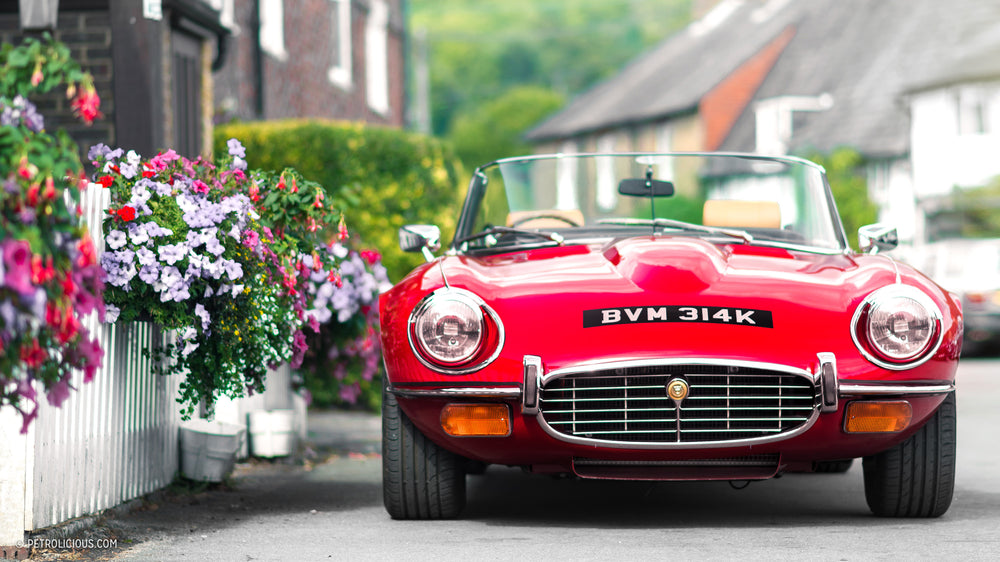Photography byPatrice Minol
When a bright chap called Malcolm Sayer put pen to paper in the late 1950s and began to sketch out a new sports car for Jaguar, it's unlikely that the former aircraft designer knew his work would go on to alter automotive history to the extent that it did.
Sayer was a pioneer. After designing aircraft during the war, he then turned his hand to cars and began to apply the principles of aircraft streamlining and aerodynamics to the automotive world. His work resulted in a sleek and slender prototype that formed the foundations of the legendary Jaguar E-Type, a machine that would later be labelled as the most beautiful car in the world by no one less than Enzo Ferrari—a good credit to one’s portfolio indeed.






By the time it came to pulling the covers off the slippery torpedo of a sports car at the Geneva Motor Show in 1961, quite literally days before the car's debut Jag founder and boss William Lyons made an 11th-hour call to bring another E-Type out to the event, correctly anticipating that the cars would generate a fair amount of interest. The job to transport the second car fell to Jaguar's now legendary test driver and developer Norman Dewis, who battled through the night to complete the dash from Coventry to Geneva just in time. Looking back, Lyons was right to bring another car out to the event. In fact, he probably could have done with a few more on the stand because when the E-Type was revealed, the motoring media kicked up such a storm that soon he had the world's rich and famous flocking to get a closer look at the E-Type's sensuous lines and rakish profile. The car was nothing short of a sensational debut.
But, in many ways, creating the first of anything is the easy part. What proves to be the real challenge is the follow-up, and, beyond that, the follow-up to the follow-up—it’s harder to create a legacy than a one-hit wonder. Enter the E-Type Series 3. Rolling off the production line in 1971 (ten years after its grandfather had broken cover in Geneva) the Series 3 was met with a stifled response. Its flared wheel arches, although matching up with the cut of most men's trousers at the time, didn't meet the expectations of a media still recounting tales of the Series 1's baptism a decade ago. With a longer wheelbase and a heavier V12 engine, critics labelled the latest E-Type as more of a cruiser than the outright sports car that Sayer had envisaged all those years ago. Although the overall design remained true to the timeless shape of the original, the car had become larger and heavier, falling victim to stricter safety regulations enforced by the United States, one of Jag's most significant markets at the time.







But there is a remedy for the Series 3's minor misgivings, and it comes from a corner of the Kent countryside. Here lies E-Type UK, a team of specialist tuners who tweak and fettle and work their magic on a variety of classic cats, such as the beautiful, bright red Series 3 pictured here.
After it left the factory in Coventry in 1971, this particular car made its way across the pond to New York City. After 40 years the Jag eventually found its way back home, arriving at the E-Type UK workshops in 2014. Getting straight to work, the team led by Dominic and Marcus Holland undertook a full restoration, returning the car to its as-new condition but with a few choice changes. Finished in the charming shade of Carmen Red, E-Type UK equipped the car with a fully re-trimmed beautiful biscuit-colored leather interior, a retro-looking Bluetooth radio unit, and 15” deep-dish wire wheels.







Despite its all but stock appearance, E-Type UK's work continued under the clam-shell bonnet, where they fitted electronic fuel injectors, stiffer front shocks, a new sports-oriented power steering rack, AP Racing front discs and calipers, and a full Haywood & Scott sports exhaust system to amplify the sonorous output of the Series 3's V12. All that makes the Series 3 a dream to pilot down the undulating country lanes; breezing past the woods, cottages, and country estates, a bright red E-Type sans roof can stir up British sentiment like little else.



With E-Type prices rising considerably over the years, the Series 3 is a tempting proposition when lined up against its elder and more expensive relatives. Add to that a touch of restomod treatment like this one has had from E-Type UK, and you’ve got yourself a highly-polished and pretty practical classic that slides seamlessly into any classic car collection. While the youngest E-Type may have deviated—albeit marginally I’d argue—from the slight and lithe sports car Sayer created in the early 1960s, there’s no denying the Series 3’s V12, and the kitsch 1970s charm make for an appealing package on its own terms. Still saving up for that old Series 1? Look no further than the youngest E-Type—even if it does wear flares.


























































